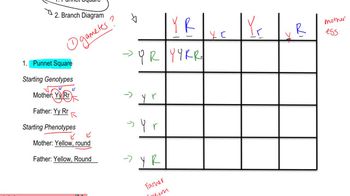Table of contents
- 1. Introduction to Genetics51m
- 2. Mendel's Laws of Inheritance3h 37m
- 3. Extensions to Mendelian Inheritance2h 41m
- 4. Genetic Mapping and Linkage2h 28m
- 5. Genetics of Bacteria and Viruses1h 21m
- 6. Chromosomal Variation1h 48m
- 7. DNA and Chromosome Structure56m
- 8. DNA Replication1h 10m
- 9. Mitosis and Meiosis1h 34m
- 10. Transcription1h 0m
- 11. Translation58m
- 12. Gene Regulation in Prokaryotes1h 19m
- 13. Gene Regulation in Eukaryotes44m
- 14. Genetic Control of Development44m
- 15. Genomes and Genomics1h 50m
- 16. Transposable Elements47m
- 17. Mutation, Repair, and Recombination1h 6m
- 18. Molecular Genetic Tools19m
- 19. Cancer Genetics29m
- 20. Quantitative Genetics1h 26m
- 21. Population Genetics50m
- 22. Evolutionary Genetics29m
2. Mendel's Laws of Inheritance
Dihybrid Cross
Problem 7
Textbook Question
Mendel crossed peas having round seeds and yellow cotyledons (seed leaves) with peas having wrinkled seeds and green cotyledons. All the F₁ plants had round seeds with yellow cotyledons. Diagram this cross through the F₂ generation, using both the Punnett square and forked-line, or branch diagram, methods.
 Verified step by step guidance
Verified step by step guidance1
<insert step 1: Identify the genotypes of the parent plants. Round seeds (R) are dominant over wrinkled seeds (r), and yellow cotyledons (Y) are dominant over green cotyledons (y). The parent plants are homozygous: RRYY (round, yellow) and rryy (wrinkled, green).>
<insert step 2: Determine the genotype of the F₁ generation. Since all F₁ plants have round seeds and yellow cotyledons, they must be heterozygous for both traits: RrYy.>
<insert step 3: Set up a Punnett square for the F₂ generation. The F₁ plants (RrYy) will produce gametes with the following combinations: RY, Ry, rY, ry. Create a 4x4 Punnett square to determine the genotypes of the F₂ generation.>
<insert step 4: Use the forked-line method to determine the phenotypic ratios. Start with one trait (e.g., seed shape) and determine the probability of each phenotype, then branch out to the second trait (e.g., cotyledon color) to find the combined probabilities.>
<insert step 5: Analyze the results from both methods to determine the phenotypic ratio of the F₂ generation. The expected phenotypic ratio for a dihybrid cross is 9:3:3:1, where 9 have both dominant traits, 3 have one dominant and one recessive trait, 3 have the other dominant and recessive trait, and 1 has both recessive traits.>
Recommended similar problem, with video answer:
 Verified Solution
Verified SolutionThis video solution was recommended by our tutors as helpful for the problem above
Video duration:
2mPlay a video:
Was this helpful?
Key Concepts
Here are the essential concepts you must grasp in order to answer the question correctly.
Mendelian Genetics
Mendelian genetics is the study of how traits are inherited through generations, based on the principles established by Gregor Mendel. It involves understanding dominant and recessive alleles, where dominant traits mask the expression of recessive ones. In this case, round seeds and yellow cotyledons are dominant traits, while wrinkled seeds and green cotyledons are recessive.
Recommended video:
Guided course

Descriptive Genetics
Punnett Square
A Punnett square is a diagram used to predict the genotypes of offspring from a genetic cross. It organizes the possible combinations of alleles from each parent, allowing for a visual representation of inheritance patterns. In this scenario, the Punnett square will help illustrate the expected ratios of round versus wrinkled seeds and yellow versus green cotyledons in the F₂ generation.
Recommended video:
Guided course

Chi Square Analysis
Forked-Line (Branch Diagram)
The forked-line or branch diagram is another method for visualizing genetic crosses, particularly useful for multiple traits. It systematically branches out the possible combinations of alleles, showing how each trait segregates independently. This method complements the Punnett square by providing a clear view of the inheritance of multiple traits, such as seed shape and cotyledon color in this cross.
Recommended video:
Guided course

Branch Diagram
Related Videos
Related Practice




